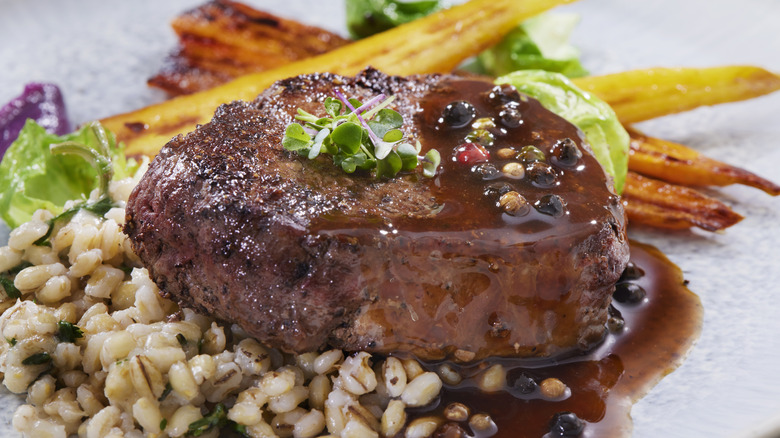The Marbling Difference You Should Know Before Cooking A Bison Steak
As the largest mammal in America, the bison yields several hundred pounds of meat on average when slaughtered — which is a lot of steak! If you've never cooked a bison steak, you might think it is similar to beef. After all, bison are just big cows, right? While the two types of meat do share similarities, it's important to highlight the differences in the meat and how they affect the cooking process. If cooked right, bison meat is prized for being both juicy and tender. But similar to venison, bison meat is leaner than beef.
In fact, according to the U.S. Department of Agriculture, bison meat has little to no marbling in its meat. For this reason, it's a deeper, darker color than you would expect from beef. This may come as a surprise to some steak lovers who praise a fatty cut of meat. For the uninitiated, marbling is white bits of intramuscular fat found in meat. Notably, beef has a lot of marbling throughout. Marbling gets its name from the marble pattern that the fat makes through the meat. For beef, marbling plays an important role when it comes to the grading of steaks.
How bison differs from beef
The USDA grading scale for beef places heavy importance on marbling, with the highest grade of beef, USDA Prime, having the most marbling. Graders also consider the type of marbling, with fine marbling, which is typically thinner and more distributed, being prized. Think Wagyu beef, for instance. With that in mind, how is bison meat ranked if it has little to no marbling?
According to the USDA, bison meat isn't graded in the United States, so you don't have the same sliding scale as you would with beef. However, the Canada Bison Grading System grades bison meat based on its age and muscling, color, and the amount of fat/types of fat present in the meat. With the lack of marbling, you would think bison meat would be less appealing to steak lovers. However, when cooked properly, bison meat can be just as tender, if not more tender than beef. Likewise, while beef and bison meat may taste similar, there are some subtle differences. In particular, bison meat has a denser, sweeter flavor compared to the lighter, more savory flavor of beef.
How to cook bison steaks
So, how should you cook a bison steak to be tender and juicy and not extra chewy and tough? Cooking a bison steak isn't too different from cooking a regular ribeye or sirloin. Think of cooking bison as a cross between cooking beef and venison. Since the meat has very little marbling, you should consider using the reverse sear method rather than the front sear method.
The reverse sear method involves cooking the steak slowly on a low heat and then finishing by browning the outside of the meat. The reverse sear method is preferred here because high temperatures can be ruinous to the more delicate meat. You don't have that fat shield as you do with beef to protect the meat from burning. The last thing you want to do with a bison steak is overcook it. Overcooking the steak will dry out the meat. Instead, the best way to enjoy a bison steak is medium rare as it allows the lean meat to remain juicy and tender. A few other things to keep in mind — let your bison steak reach room temperature before cooking for a more even cooking. Also, let your steaks rest for a few minutes after cooking for more flavorful, juicier results.


